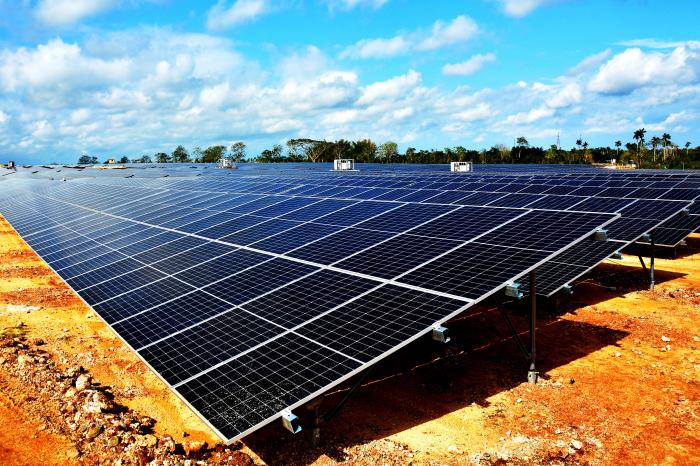In a conversation with Granma, the Minister of Energy and Mines explains how the country is working with the highest priority to strengthen the National Electricity System, expand generation capacity with sustainable matrices and eliminate chronic blackouts.
Having electricity is not a luxury. Lack of it makes every family suffer, not only for not being able to turn on the TV or charge the phone but -even more essential- for running out of options for cooking or preserving food that requires refrigeration.
The country suffers, unable to set foot on the right path of the urgent development it needs, because no progress can be made with a factory shut down due to lack of electricity, nor is it possible to do business with the office shut down, nor can there be fluid communication or sufficient reproduction of knowledge because the electricity, telephone and internet coverage disappears.
The prolonged instability of the National Electricity System (SEN), due to the constant breakdowns in the thermal base, in addition to the fuel shortages that have limited the operation of distributed generation, means that the majority of the population, which has been affected by the very long blackouts, is placing all its hopes in the synchronisation of the large solar parks that are under construction.
Vicente de la O Levy, Cuban Minister of Energy and Mines, gave a detailed interview to Granma to answer and explain several questions about the progressive recovery of electricity generation, the investments underway, their sustainability, what will contribute most quickly to reversing the current crisis, and the revitalisation of other sources that would diversify the country’s energy matrix.
-Minister, let us start from the possible – and announced – ideal that, by 2025, around fifty wind farms will be incorporated into generation, and that at least a thousand megawatts (mw) of availability will be exceeded in this way. If we compare this with the current average daily deficit, will this mean, mathematically, that at least two thirds of the blackouts that occur today will be reduced? Can it be interpreted in this way?
-The concern is logical, logical and intelligent. Our people are well trained, and they know the terms megawatt, deficit, generation, loss… and doubts like these arise.
«But the recovery is not with solar photovoltaic parks alone. It is a programme, of course, in which the most notable or the most innovative, the most different, are the solar photovoltaic parks.
«But you have to look at the electricity system from different angles. One issue is fuel because fuel production – just as the National Electricity System was being depressed – was also decreasing, to the extent that it was analysed that there would come a time when we would not even have enough fuel for the thermoelectric plants. We are talking about national crude oil, and the accompanying gas to generate electricity.
«In the end, in the approved design, discussed with the Cuban professors, with the universities, with the research centres – which is a work that has been going on for many years – we concluded that we have to seek independence in fuel imports.
«We have always been dependent on fuel imports, to the point that the oil bill is the largest in Cuba; more than food, more than medicines, more than everything. AOfthe fuel imported to sustain the entire economy, electricity generation is the biggest consumer: more than half of all the fuel the country uses is to generate electricity.
«Agriculture, water pumping, harvesting, transport, the whole chain of the domestic economy, all consume less than electricity generation.
«And yet national fuel production was decreasing, while the trend was that the consumption of thermoelectric plants, in oil and gas, was going to be higher than national production. That, on the one hand.
«So the electricity issue started to become more complicated, not only because of the technical state of the thermoelectric plants…».
-Was this decrease related to the availability of natural oil and gas, or to the capacity to extract them?
-It had to do with the same causes that affected the thermoelectric plants: deterioration, lack of resources, and lack of spare parts. Oil production is not about drilling a well and that’s it, it starts to come out. No.
«Drilling a well is an investment, but then maintaining that well requires resources, which have to be invested every day, and the shortage forced us to close wells, close and close because we didn’t have the inputs to keep those wells active.
«To give an example, you open a well, you start extracting oil, and that oil in Cuba is dumped in tanks. And after it’s in the tank, you have to take it out of the tank and transport it by road.
«In Cuba, there are very few pipelines. For example, from Matanzas to the Santa Cruz thermoelectric plant it is by pipeline; from the ports to the refineries it is by pipeline; but not to all the thermoelectric plants or to the distributed generation it is by pipeline. A lot has to be transported by road.
«So, if the tank fills up and you don’t have a transportation infrastructure to carry the crude you took from the wells, you have a bottleneck that also limits your oil production.
«In addition, the wells have to be constantly being treated with chemicals, solvents, a lot of chemicals and solvents.
Plus the crude nature of our oil…
– Exactly. In our wells that complicates it even more; but we also have to support the surface installation, valves, pipes, pumps… all of that needs constant maintenance, repairs that we couldn’t do.
«This limited production, as well as not being able to invest in new wells and seismic studies. You always have to be ahead in seismic studies, in drilling, to then extract.
«We managed, in 2023, to drill some wells, to obtain gas; and yes, gas was obtained, and that was what managed to recover and increase the generation of electricity with gas, but the production of crude oil continued to decrease. And in that analysis we concluded that there would come a time when not even domestic crude oil would be enough for thermoelectric plants. What’s more, if we had all the thermoelectric plants available, it wouldn’t be enough.
-Our crude oil would not be enough?
-Not even our crude oil. Then there is distributed generation based on diesel and fuel oil, which are imported; those or refined crude oil, because Cuban oil is not refined, is burned directly in the thermoelectric plants.
«It is not a crude oil that you can take to any of our four refineries and obtain diesel, or gasoline, naphtha, liquefied gas, turbo-fuel for aviation… It is only suitable for thermoelectric plants, which were designed and adapted to this type of fuel.
«The Cuban thermoelectric plants, by design, consumed fuel of excellent quality that came mainly from the former Soviet Union. Under those conditions, the life between maintenance was much longer. And when the Soviet Union disappeared, we stopped having, overnight, all the fuel, which amounted to 12 million tonnes.
«So we were forced to start converting the thermoelectric plants, with a Cuban innovation, so that they would consume national crude.
«That saved us, but it came at a high sacrifice. What was that? The life of the thermoelectric generation units was shortened, the time between maintenance, because Cuban crude has a very high sulphur and vanadium content, which when combusted in the boilers and there is humidity, generates sulphuric acid, which accelerates corrosion.
«This is added to the deterioration caused by old age, due to the years of operation of the thermoelectric plants. Mariel, for example, was inaugurated in 1975, and the youngest one is already more than 25 years old. You can maintain anything that has the required maintenance for a hundred years, 200 years, with all the resources it requires; but if a bearing lasts 60,000 hours, and after 60,000 hours you don’t change it, it will break, and it starts to trigger a progressive deterioration of the system».
-There is a number that is very illustrative of the difference that was dedicated annually to the maintenance of the generation, and that with the pandemic was drastically reduced.
-I was director of the Unión Eléctrica when, as part of the great investment process of the Energy Revolution, there were more than a billion, 1.2, 1.3 billion. There were years very close to 2 billion that were put into the entire electricity system.
«Not only for maintenance; there were investments and also, in parallel or collaterally, the whole process of changing electrical appliances, light bulbs, refrigerator gaskets, the introduction of rice cookers and cookers; but all of this contributed to electricity, to reducing demand and consumption and reducing the use of fuel.
«Now, just for generation maintenance, if the electricity system were working well, every year we would have to put between 250 and 350 million dollars into it. One year that you stop putting those resources into it, it doesn’t recover; and it hasn’t been just one year. That is the bill we are paying. It has not been possible, the country has not had enough income, because of the limitations we know.
«So, if oil production is decreasing, if we don’t have the finances to import again the millions of tonnes that the economy needs, the first thing to do is to stop that decrease, at the same time as reducing fuel consumption, while expanding generation capacity.
«That is when it was decided to move forward with solar photovoltaic panels, and more than panels, to expand the plans for the use of renewable energy sources.
«Why do panels become the biggest project? First, the investments are less expensive. They are done faster because they can be spread all over the country.
«With the first calculations we, said: «yoYouan install 1 000 MW in one year». Some colleagues warned that it would be too much of an investment process in this situation where there is no cement, steel, and many other resources. How are we going to ensure the installation of 1,000 MW?
«We are going to analyse it differently. If we do it in parks of 21 MW, and we distribute them across 15 provinces, at an average of three per province, then it is an economic effort that can be made territorially.
«The investors and the electricity organisations are in each territory, just like the structures of the Ministry of Construction; in other words, it is distributed and that is what is happening at the moment, an open investment process throughout the country».
-And what happens when there is no sun, when there is a hurricane?
-Those are two of the reasons why it’s spread across the country. There may be shade, now, in the first park we inaugurated, in Cotorro; but in Granma, there is bright sunshine.
«The average designed distance between parks is only eight kilometres. There can be shade in the area of one park, and in the other, eight kilometres away, there doesn’t have to be the same shade.
«It is a distribution design that also helps with voltage regulation, from the National Load Despatch, and through a system that is also coming into being with the installation.
«Of course, the challenges will be greater to maintain an electricity system with a high level of renewable energy penetration. Something similar was the case when distributed generation was introduced. We had large thermoelectric generation plants, and within two years 202 distributed generation sites were installed across the country. That was a challenge for the operation of the SEN, which included preparing the human capital that would operate it».
-With these parks generating energy at full sun, are you thinking of creating capacities to store energy for the night, to accumulate loads in batteries, or will there continue to be a deficit at night?
-It is also conceived to incorporate a level of energy storage; in principle, to guarantee the stability of the electricity system.
«In other words, there are concepts of energy accumulation for stability, and there are concepts of energy accumulation to deliver to the system. The first accumulation containers are already in Cuba, but they don’t yet have the battery inside.
«Let’s say there is the whole container, with all the automatic parts, electronics and other components. Only at the end is the battery put in. Why was it contracted like that? Because the batteries don’t have to be left uncharged for a certain period, and it’s not the most complex thing to put them in. By way of a simple explanation: they are like drawers that have to be fitted, and that’s it, but for the rest we can go ahead».
-It will be necessary to elaborate on this explanation later, but let’s go back to the mathematical account at the beginning. When 1,000 MW of panels are available, will there be two-thirds fewer blackouts than today, when the deficit at the peak is 1 500 MW?
-When you say there is an average of 1 500 mw deficit, that is at one time of the day. And if we install 1,000 mw, will there be 500 mw of deficit? Well, no, because of the 1,500 mw, there were days when 1,000 mw was due to fuel.
«That’s why the country is determined to cover this deficit with renewable energies because you can’t make investments that imply more fuel; although it is also a priority to grow in fuel production, it is inexorable to make progress in reducing the consumption of that fuel.
«Let’s take an example. The last time Felton was out of the system, due to a breakdown, on that date there was no impact on the service in the early morning, nor was there a big difference with the deficit of the previous days. How did that happen? Was it because of the weather?
«No, it wasn’t the weather. It’s that we had fuel that day. For all the distributed generation on that day, we had fuel, and the shortfall was covered. In other words, it is not just a question of technological generation capacity.
«The deficit would be covered by maintaining this high technological capacity, buying fuel, with the distributed generation plants all working, and adding the wind farms.
«What is certain is that, when we put in 1,000 MW of renewable energy, we will be saving fuel, which is the fuel that we can throw away for generation at night.»
How will the system operate in an ideal where all these farms are synchronised? At least these, which do not have storage, will they only provide power during the day, and how far is it planned to go with the installation of batteries that accumulate the charge for when there is no sun?
These and other questions will be answered in this interview, which will be available to Granma readers in several parts, to be continued in the next edition.
ON NATIONAL OIL PRODUCTION FOR ELECTRIC GENERATION
- At the end of 2024, the lack of material resources and financing caused the production of national crude oil to decrease by 138 028 tonnes.
- Daily, 40,000 barrels are produced, but they only cover a third of consumption.
- Cuban wells produce only 6 % of the crude in the ground. Research is needed on how to increase this value to 10-11%, which would double production.
- Areas where oil deposits exist have been identified: Boca de Jaruco, between Fraile and Jibacoa; the area of East Havana and Alamar; and to the south of the Puerto Escondido and Canasí oilfields.
- There is an urgent need to encourage exploration to discover better quality crude oil and to explore offshore fields.
- This year, an exploration campaign is planned to add three to five wells.
Source: Interview with Osvaldo López Corso, head of the Exploration and Reservoir Group of the Cuba-Petroleum Union (Cupet).




